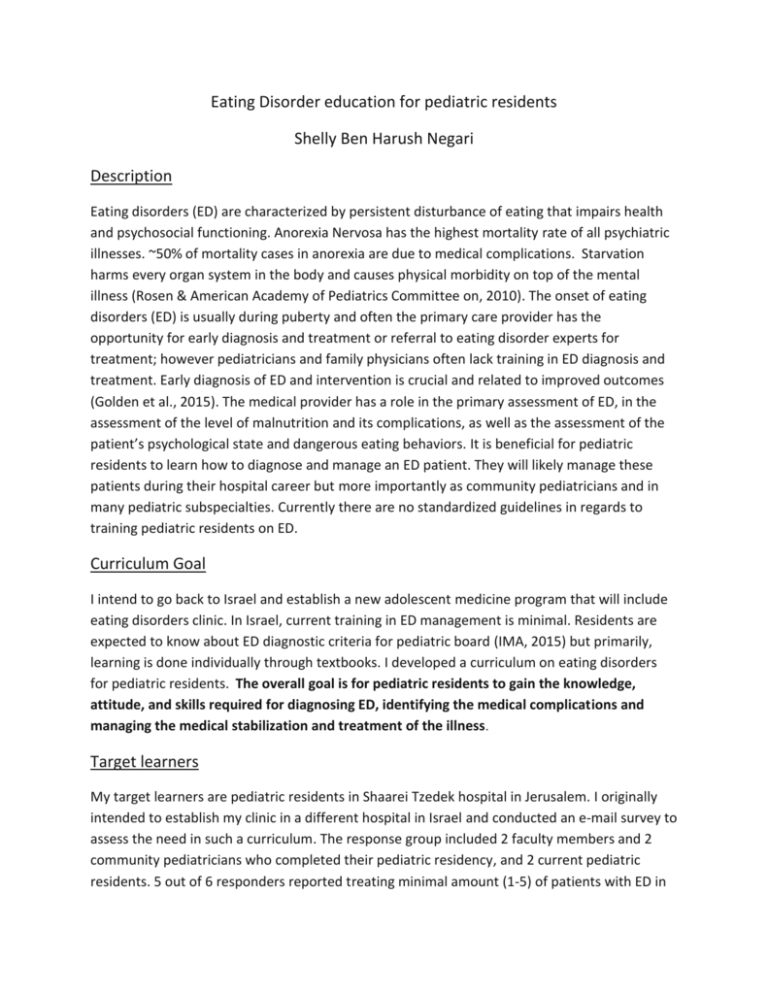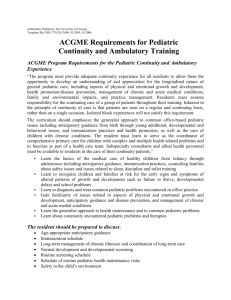Eating disorder education for pediatric residents
advertisement

Eating Disorder education for pediatric residents Shelly Ben Harush Negari Description Eating disorders (ED) are characterized by persistent disturbance of eating that impairs health and psychosocial functioning. Anorexia Nervosa has the highest mortality rate of all psychiatric illnesses. ~50% of mortality cases in anorexia are due to medical complications. Starvation harms every organ system in the body and causes physical morbidity on top of the mental illness (Rosen & American Academy of Pediatrics Committee on, 2010). The onset of eating disorders (ED) is usually during puberty and often the primary care provider has the opportunity for early diagnosis and treatment or referral to eating disorder experts for treatment; however pediatricians and family physicians often lack training in ED diagnosis and treatment. Early diagnosis of ED and intervention is crucial and related to improved outcomes (Golden et al., 2015). The medical provider has a role in the primary assessment of ED, in the assessment of the level of malnutrition and its complications, as well as the assessment of the patient’s psychological state and dangerous eating behaviors. It is beneficial for pediatric residents to learn how to diagnose and manage an ED patient. They will likely manage these patients during their hospital career but more importantly as community pediatricians and in many pediatric subspecialties. Currently there are no standardized guidelines in regards to training pediatric residents on ED. Curriculum Goal I intend to go back to Israel and establish a new adolescent medicine program that will include eating disorders clinic. In Israel, current training in ED management is minimal. Residents are expected to know about ED diagnostic criteria for pediatric board (IMA, 2015) but primarily, learning is done individually through textbooks. I developed a curriculum on eating disorders for pediatric residents. The overall goal is for pediatric residents to gain the knowledge, attitude, and skills required for diagnosing ED, identifying the medical complications and managing the medical stabilization and treatment of the illness . Target learners My target learners are pediatric residents in Shaarei Tzedek hospital in Jerusalem. I originally intended to establish my clinic in a different hospital in Israel and conducted an e-mail survey to assess the need in such a curriculum. The response group included 2 faculty members and 2 community pediatricians who completed their pediatric residency, and 2 current pediatric residents. 5 out of 6 responders reported treating minimal amount (1-5) of patients with ED in the past year. They reported even lower rates of diagnosing ED themselves. (2 responders never diagnosed and 3 diagnosed 1-5 cases). Most of the responders (4/6) reported low level of confidence in diagnosing ED and its medical complications. All the responders reported having no confidence in treating ED in an ambulatory clinic. Therefore I believe that there is a need in such an education. Schedule and plan The overall teaching on eating disorder will include 3 methods: Teaching method Bed side teaching Activity Bed side teaching at morning rounds Didactic activities Team based learning session 1: Introduction, data gathering Team based learning session 2: group presentations Role play and small group discussions Shadowing in the ED ambulatory clinics Residents will shadow in multidisciplinary ED clinic Topic Review of the primary management of ED patients admitted overnight. Monitor for ED complications. ED presentation and complication The multidisciplinary team work and treatment strategies, communication with the family of ED patient Multidisciplinary team work, communication with the family of ED patient Time Inpatient rotation Afternoon conference 1 hour Afternoon conference 1 hour Afternoon conference 1.5 hour Outpatient clinic rotation Cognitive objectives: 1. By the end of the curriculum, each resident will be able to identify various clinical presentations of ED and be able to classify them according to the different diagnoses 2. By the end of the curriculum, each resident will be able to List 5 complications of Anorexia Nervosa and 3 of Bulimia Nervosa 3. By the end of the curriculum, each resident will be able to describe the correct clinical management of medically unstable ED patient Behavioral objective: Each resident will be able to discuss treatment options for ED patient in a role play activity Attitude objective: The residents will recognize the importance of a multidisciplinary approach to ED treatment Outcomes TBL activity: 1. The pediatric resident will work as a group to create consensus answer to the knowledge pre- test 2. The residents in each group will create a presentation summarizing a specific topic about eating disorder 3. Each pediatric resident will provide feedback to other group’s presentation. Role play and small group discussion: 1. Each pediatric resident will simulate a discussion between a patient and a physician or a patient family member and a physician in role activity. 2. By the end of the role play activity the resident will identify the challenges in communication about eating disorder issues. Strategy In order to help the residents recognize the importance of a multidisciplinary team work and to help them understand the role of each team member in the care of eating disorder patients I created a maze (attached as artifact) that follows the phases of treatment. The learner needs to help the animated patient cross the maze to recovery. In this journey to recovery the resident meets the different care providers and their role in the care. Following the tip about cognitive flexibility, the maze also serves as a way to understand this illness from the patient’s perspective and to see that sometimes the medical system can appear complicated as a maze. I hope that by solving the maze the learners will get the chance of experiencing the detailed picture but also have a general vision of the big picture. The Maze will be given as an introductory to the adolescent rotation before the residents shadow in clinic or work in the inpatient unit. Currently I created a paper version but ultimately would like to create an interactive Pac-man version. Ethics I will include specific guidelines regarding the use of source materials for the presentations. Also prior to the inpatient rotation and the outpatient rotation there will be a discussion about confidentiality. The work with eating disorder patients and their family often includes revealing of intimate information about the families. As part of the training the residents will learn how to be sensitive during these fragile conversations and how to make sure the patient’s information is not shared with others. Artifacts 1. 2. 3. 4. Description of TBL learning activity+ assessments+ rubrics for grading TBL activity Maze on eating disorders Screen cast of graphic design for the neurobiologic etiologies of eating disorders Survey sent to pediatric residents to assess the need in the curriculum Golden, N. H., Katzman, D. K., Sawyer, S. M., Ornstein, R. M., Rome, E. S., Garber, A. K., . . . Kreipe, R. E. (2015). Update on the Medical Management of Eating Disorders. Journal of adolescent health, 16. IMA. (2015). תחומי- סילבוס מורחב-[ ידע פרטניים רפואת ילדיםpediatric medicine- extended sylabusspecific knowledge fields] Retrieved from http://www.ima.org.il/Internes/ViewCategory.aspx?CategoryId=6908#.VNgSrGd0xjo Rosen, D. S., & American Academy of Pediatrics Committee on, A. (2010). Identification and management of eating disorders in children and adolescents. Pediatrics, 126(6), 1240-1253. doi:10.1542/peds.2010-2821







